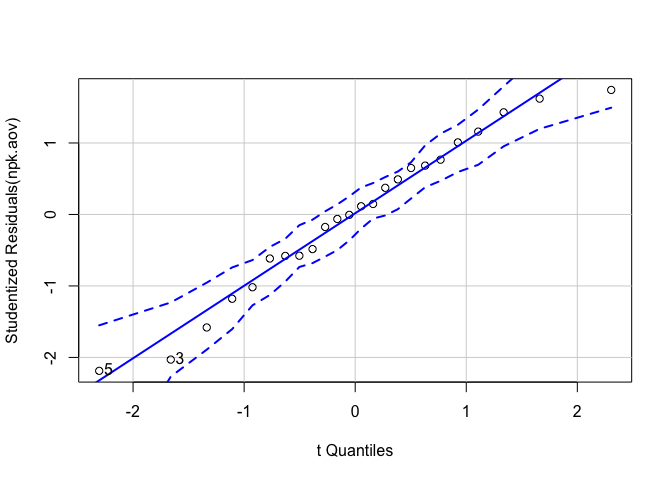Hi, and welcome!
One way to do this is with qqPlot() in the cars package, although you do get an envelope to go with it.
From help(aov) first example
library(car)
#> Loading required package: carData
op <- options(contrasts = c("contr.helmert", "contr.poly"))
( npk.aov <- aov(yield ~ block + N*P*K, npk) )
#> Call:
#> aov(formula = yield ~ block + N * P * K, data = npk)
#>
#> Terms:
#> block N P K N:P N:K
#> Sum of Squares 343.2950 189.2817 8.4017 95.2017 21.2817 33.1350
#> Deg. of Freedom 5 1 1 1 1 1
#> P:K Residuals
#> Sum of Squares 0.4817 185.2867
#> Deg. of Freedom 1 12
#>
#> Residual standard error: 3.929447
#> 1 out of 13 effects not estimable
#> Estimated effects are balanced
summary(npk.aov)
#> Df Sum Sq Mean Sq F value Pr(>F)
#> block 5 343.3 68.66 4.447 0.01594 *
#> N 1 189.3 189.28 12.259 0.00437 **
#> P 1 8.4 8.40 0.544 0.47490
#> K 1 95.2 95.20 6.166 0.02880 *
#> N:P 1 21.3 21.28 1.378 0.26317
#> N:K 1 33.1 33.14 2.146 0.16865
#> P:K 1 0.5 0.48 0.031 0.86275
#> Residuals 12 185.3 15.44
#> ---
#> Signif. codes: 0 '***' 0.001 '**' 0.01 '*' 0.05 '.' 0.1 ' ' 1
coefficients(npk.aov)
#> (Intercept) block1 block2 block3 block4 block5
#> 54.8750000 1.7125000 1.6791667 -1.8229167 -1.0137500 0.2950000
#> N1 P1 K1 N1:P1 N1:K1 P1:K1
#> 2.8083333 -0.5916667 -1.9916667 -0.9416667 -1.1750000 0.1416667
qqPlot(npk.aov)

#> [1] 3 5
Created on 2019-11-03 by the reprex package (v0.3.0)
BTW: Notice that I've used a reproducible example, called a reprex, which always helps questions get more answers.